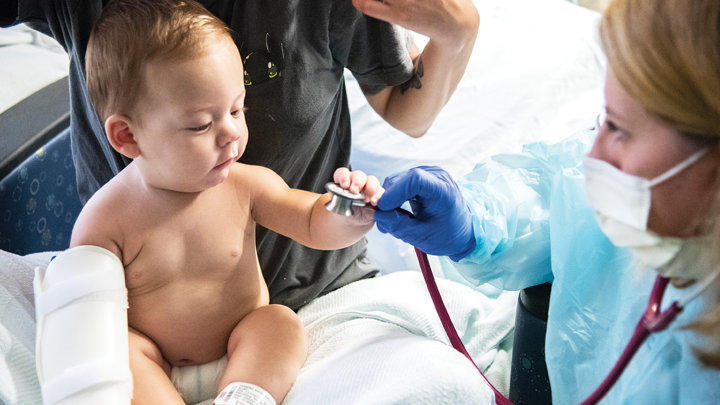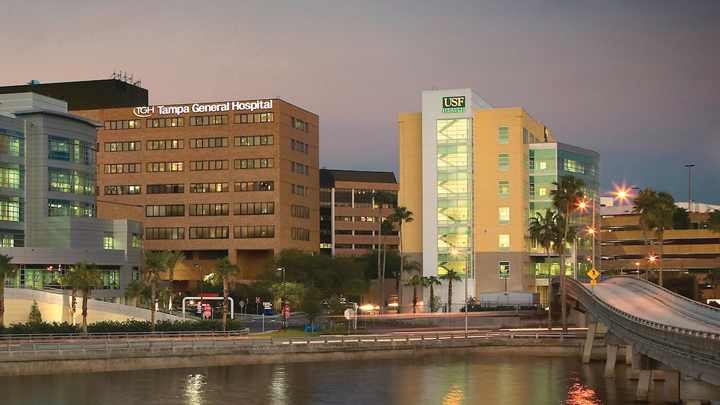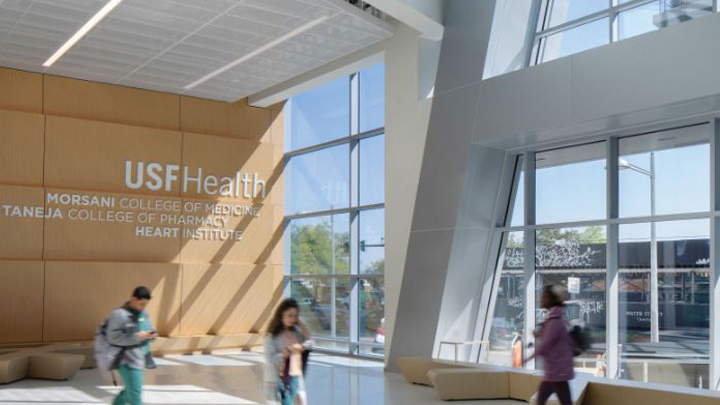Current Features
USF Health Trains the Region’s Health Workforce
Generates research grants and biotech spinoff businesses

The power of academic medicine
By Sarah Worth ’86 | USF Health Communications
ACADEMIC MEDICAL CENTERS (AMCs) across the country attract the brightest minds and care for the sickest patients with the most complicated medical conditions.
They are hubs of surgical innovation, scientific discovery and, many times, miraculous cures.
They are also employers to countless jobs and attractors for related biomedical and pharmaceutical industries that can add to local job numbers.
Through their education, research and patient care work, AMCs across the United States support more than 6.3 million jobs in multiple industries — translating to almost 3.3% of all jobs nationwide, as reported by the Association of American Medical Colleges (AAMC) in a 2018 study on the economic impact of AMCs. These institutions, the report notes, pay more than $386 billion in aggregate annual wages, salaries and benefits.
In Tampa, USF Health is an AMC.
With its four colleges, health-focused schools and programs, and its multi-specialty faculty practice plan, USF Health as a whole directly employs about 8,000 people. And a new enhanced affiliation with Tampa General Hospital greatly expands the footprint for Tampa Bay’s AMC.
Add to that the ripple effect that just the clinical operations has on the local and state job market (suppliers, construction, insurance carriers, deliveries, technology support, etc.) and USF Health’s impact on employment jumps by nearly 20,000 other people with overall labor income of $527.5 million. That equates to a value added (a measure of the contribution to GDP) $721.2 million and an output (the total value of production of goods and services generated through USF Health-related spending) of more than $1 billion.
“USF Health has become a powerhouse for economic growth through training our region’s health work force, generating research grants and biotech spin-offs and creating one of the largest multispecialty practices in Florida caring for some of the sickest patients in the state with among the best outcomes in the nation, particularly during the COVID-19 pandemic,” says Dr. Charles Lockwood, senior vice president for USF Health and dean of the USF Health Morsani College of Medicine. “As part of the region’s only academic medical center, USF Health is recognized for not only advanced care, treatments and cures, but also for providing significant economic impact and opportunity. Families, leaders and donors across our state visibly recognize the economic value USF Health brings to our community, not just in terms of jobs but also the types of jobs.”
And the new endeavor with Tampa General will likely elevate all of these metrics even more.
USF Tampa General Physicians

In July 2020, USF and Tampa General Hospital announced a new enhanced affiliation that will expand the impact of each organization, and allow for additional economic impact and growth of a new organization, the USF Tampa General Physicians (USFTGP). In essence, USFTGP will be one of the largest academic medical groups in Florida.
USF Health and TGH have been closely aligned since the formation of USF’s medical school 50 years ago. In fact, TGH has long been the primary teaching hospital for countless USF medical, nursing and pharmacy students, and most Morsani College of Medicine faculty see patients or provide surgeries and procedures at TGH, and many USF faculty lead key TGH services and departments.
This enhanced affiliation and launch of USFTGP adds to that rich history, not only by creating a model mirrored across the country — that of an AMC closely aligning with a region’s hospital or health care system – but also expanding the reach and impact of Tampa Bay’s only academic medical center to patients and their families.
“We’re taking the foundation built by USF Health over the decades and coupling it with TGH and its expansive growth in services and reputation,” Lockwood says. “As a new entity, USFTGP will support both USF Health and TGH in the long run, as the health-care landscape continues to shift away from fee-for-service models to value-added care. USFTGP will also give patients greater access to advanced care as it grows in number of providers, services and locations.”
USFTGP creates a combined management services organization with more than 800 health-care providers under a unified management structure, becoming one of the largest academic medical groups in Florida. The new nonprofit organization was created by joining the administrative infrastructure of Tampa General Medical Group (TGMG) and the USF Health physician faculty practice group. Once fully launched, the organization will provide unified management and support structure for physicians employed by both USF Health and TGMG, allowing for more coordinated care and increased patient access to the kind of world-class, specialized care typically found only at academic medical centers. The new organization also promotes coordinated and strategic planning, investment, and joint accountability across both organizations’ shared clinical, research and teaching efforts.
Transition planning has taken place since announcing the broadened affiliation last summer, and USFTGP is going live across the end of 2021 and beginning of 2022. Patients of both USF Health and Tampa General Medical Group will likely not see changes to their care, appointments or how they access their health-care providers until well into 2022.
Morsani College of Medicine + Heart Institute

A single building might not tip the scales for economic impact — unless that building is the new Morsani College of Medicine and Heart Institute in downtown Tampa, referred to as MDD.
Opened in January 2020, the 13-floor, 395,000-square-foot structure was the first building to break ground and the first to open in the new Water Street Tampa district of downtown Tampa, a $3 billion redevelopment project spearheaded by Strategic Property Partners, a joint venture of Jeff Vinik (who owns NHL Stanley Cup double champions Tampa Bay Lightning), and Cascade Investment LLC, led by Bill Gates. The design construction firm for the building was Skanska/HOK.
At the corner of Meridian Avenue and Channelside Drive, the new MDD helps expand USF’s downtown footprint already started with the Center for Advanced Medical Learning and Simulation (CAMLS) and the South Tampa Center for Advanced Healthcare (one of two flagship clinical facilities for the Morsani College of Medicine), and puts the medical school in closer proximity to TGH, USF Health’s primary teaching hospital.
This newly opened facility is causing various waves of impact — all adding to the overall economic impact of USF Health both now and projected for the future.
Since the announcement of the building some six years ago, metrics across many areas have soared, most notably the caliber of students vying for coveted spots in the MD program of the USF Health Morsani College of Medicine, and the success in recruiting top National Institutes of Health-funded researchers to the USF Health Heart Institute.
Counted also is the incredible ripple effect a construction project of this size had on local jobs, from the actual design and construction to the support of businesses that supplied building materials, furnished the building and are now helping to maintain MDD.
Once it opened in early 2020, the facility brought about 1,800 students, faculty and staff to live, work, study and conduct research along the downtown waterfront, all of whom are contributing to other lanes of the economy through real estate, retail and additional consumer activity.
And there’s more on the horizon: In addition to USF Health’s MD program and the Heart Institute, the building is designed to hold the Taneja College of Pharmacy, which is on target to move there in early 2023, as well as TGH for collaborative efforts focused on cardiology, urgent care, imaging and executive wellness. TGH leased approximately 25,000 square feet of space in the building.
“We knew our building would help attract the best in education and research to USF and contribute to the district’s knowledge economy, and data are proving both our immediate impact and extraordinary potential future impact,” Lockwood says.
The Heart of Research
To further illustrate how the success of an academic medical center like USF Health will pay off economically for decades, focus a moment on research in the USF Health Heart Institute.
One of the primary components of the institute is a plan to recruit about 30 NIH-funded researchers over several years. That level of effort does more than simply hire a researcher because, for each scientist hired, there are many positions that support that researcher, most of which are high-skill, specialized jobs, including more doctoral students and a host of support scientists and technicians. Add to that the need for each lab to complete its setup, buy equipment and stock supplies, and you can see USF Health’s continuous wave of impact across the region for years to come.
Much of that impact is already in motion: to date, The Heart Institute has successfully recruited about 15 researchers. And, with the forecast including 15 more, the future impact continues the drumbeat that research now impacts the economy across time.
Research funding is certainly a piece of any economic impact reporting, and USF Health clearly leads in that arena.
Research funding for USF Health’s four health-related colleges, schools and programs regularly accounts for more than two-thirds of USF’s overall research awards and contracts. In fiscal year 2020, USF Health was awarded $378.6 million – about 70% – of USF’s $535.4 million research contracts and grants.
Another metric to consider is patents: over a third of all USF patents and licenses went to USF Health faculty in fiscal year 2021.
And steady increases in federal funding over recent years is also a badge of honor for USF Health, seeing increases in NIH funding across the last six years of 68.8%, going from $102,062,442 in fiscal year 2015 to $172,234,325 in fiscal year 2021.
And it’s a known formula: every $1 in funding from the National Institutes of Health will spark at least $2.35 into the local economy.
So, with the 2021 NIH total above, USF Health’s NIH funding alone should lead to about $404.7 million going into the Tampa Bay area economy, a clear impact spurred on by this region’s only academic medical center.